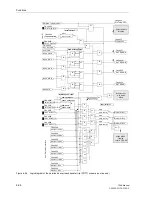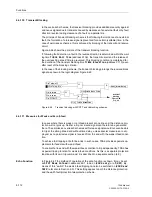
Functions
6-97
7SA6 Manual
C53000-G1176-C156-2
In protective relays equipped with a protection data interface, address 121
Teleprot. Dist.
allows to set
Protection Interface
. At address 2101
FCT
Telep. Dis.
POTT
can be set.
Figure 6-55
Operation scheme of the permissive overreach transfer trip method
Sequence
Figure 6-56 shows the logic diagram of the signal comparison scheme for one line
end.
The permissive overreach transfer trip only functions for faults in the forward direction.
Accordingly, the overreaching zone Z1B of the distance protection must definitely be
set to
Forward
: address
1351
Op. mode Z1B
, refer also to Sub-section 6.2.4.2 un-
der margin heading “Controlled Zone Z1B”.
On lines with two ends the signal transmission may be phase segregated. Send and
receive circuits in this case are built up for each phase. On three terminal lines the
send signal is transmitted to both opposite ends. The receive signals are then com-
bined with the logical AND function, as all three line ends must transmit during an in-
ternal fault. Via the setting
Line Config.
(address
2102
) the device is informed as
to whether it has one or two opposite line ends. In protective relays equipped with one
or two protection data interfaces, signal transmission is always phase segregated.
In the case of faults in the transmission path, the overreaching zone Z1B can be acti-
vated by an automatic reclose device, via the binary input “
>Enable ARzones
” and
address
1357
“1st AR -> Z1B” set to “Yes” (refer to Figure 6-38 bottom).
The influence of signals resulting from transients during clearance of external faults or
from direction reversal during the clearance of faults on parallel lines, is neutralized by
the “Transient Blocking” (refer to Sub-section 6.6.1.10).
On feeders with single-sided infeed, the line end with no infeed cannot generate a re-
lease signal, as no fault detection occurs there. To achieve tripping by the permissive
overreach transfer scheme even in this case, the device contains a special function.
This “Weak Infeed Function” (echo function) is referred to in Sub-section 6.6.1.11. It
is activated when a signal is received from the opposite line end — in the case of three
terminal lines from at least one of the opposite line ends — without the device having
detected a fault.
The circuit breaker can also be tripped at the line end that has only weak or no infeed.
This “Weak-Infeed Tripping” is referred to in Section 6.9.
T1B
Z1B
receive.
transmit
A
B
Z1(A)
Z1(B)
Z1B(A)
Z1B(B)
T
S
&
≥
1
trip
receive.
further
zones
&
Z1 or
≥
1
T
S
&
trip
transmit
further
zones
&
Z1 or
≥
1
(A)
T1B
Z1B
(B)
≥
1
Summary of Contents for siprotec 7SA6
Page 2: ...Siemens Aktiengesellschaft Book No C53000 G1176 C156 2 ...
Page 18: ...xviii 7SA6 Manual C53000 G1176 C156 2 ...
Page 32: ...Introduction 1 14 7SA6 Manual C53000 G1176 C156 2 ...
Page 82: ...Hardware and Connections 2 50 7SA6 Manual C53000 G1176 C156 2 ...
Page 119: ...SIPROTEC 4 Devices 4 25 7SA6 Manual C53000 G1176 C156 2 Figure 4 20 CFC Logic example ...
Page 190: ...Configuration 5 62 7SA6 Manual C53000 G1176 C156 2 ...
Page 652: ...Installation and Commissioning 8 78 7SA6 Manual C53000 G1176 C156 2 ...
Page 724: ...Technical Data 10 56 7SA6 Manual C53000 G1176 C156 ...
Page 800: ...Appendix A 76 7SA6 Manual C53000 G1176 C156 2 ...
Page 866: ...Appendix B 66 7SA6 Manual C53000 G1176 C156 2 ...
















































